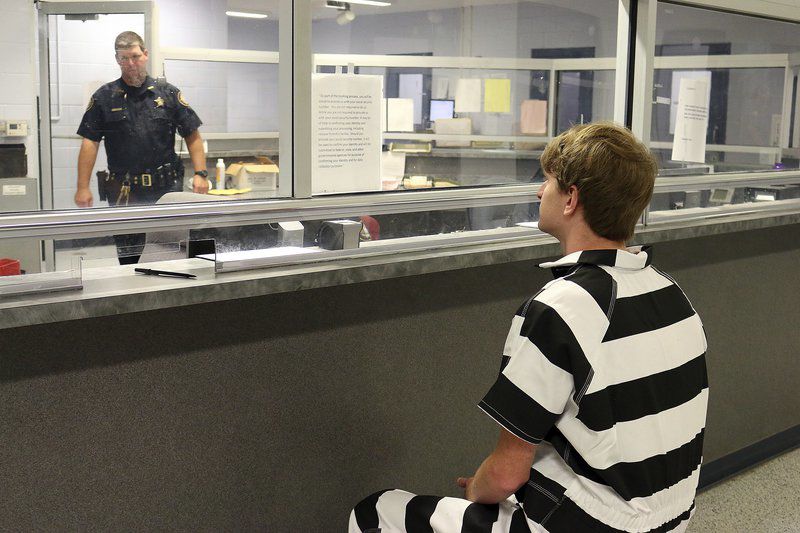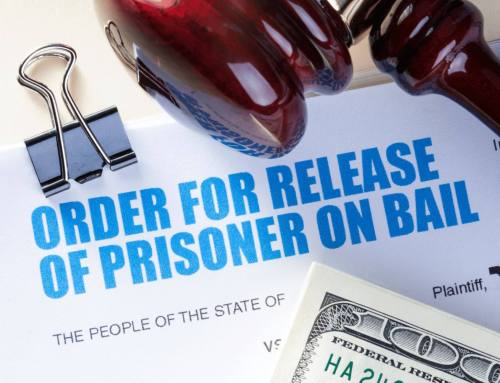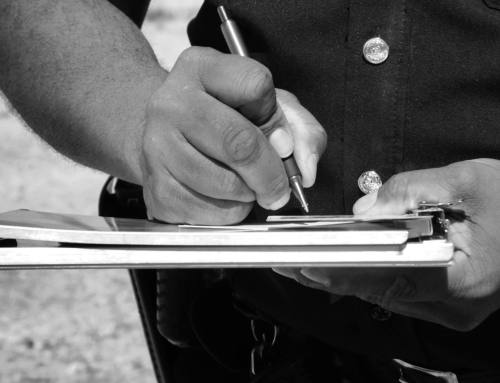If you watch much television, you’ve probably seen variations of this scene dozens of times: a judge bangs a gavel and announces, “Bail is set at $100,000.” The defendant looks despondent as he consults with his lawyers. But somehow he ends up free while waiting for his trial to begin. One hundred thousand dollars is a lot of money to come up with — how did he afford it? And what did it mean when the defense attorney claimed his client was not a “flight risk”? Bail works by releasing a defendant in exchange for money that the court holds until all proceedings and trials surrounding the accused person are complete. The court hopes that the defendant will show up for his or her court dates in order to recover the bail.
In many cases, trials can begin weeks or months after an initial arrest, and if not for bail, many people, some of whom might be innocent, would have to wait in jail until their trials began. At the minimum, this can present a financial hardship, as the person would be unable to work. And, the person would also be missing his or her life — family events, holidays, etc. Not everyone who is released on bail is eventually acquitted, so to prevent particular dangerous suspects from being released, several safeguards have been built into bail law. In this article, we’ll learn about those safeguards, how the bail process works and how this system has changed since it was first started in England centuries ago.
The Bail Process
When someone is arrested, he or she is first taken to a police station to be booked. When a suspect is booked, or processed, a police officer records information about the suspect (name, address, birthday, appearance) and the alleged crime. The police officer conducts a criminal background check, takes the suspect’s fingerprints and mugshot and seizes and inventories any personal property, which will be returned when the suspect is released. The suspect is also checked to see if he or she is intoxicated and usually is allowed to make a phone call. Finally, an officer puts the suspect in a jail cell, usually with other recently booked suspects.
For less serious crimes, a suspect may be allowed to post bail immediately after being booked. Otherwise, the suspect will have to wait (usually less than 48 hours) for a bail hearing where a judge will determine if the accused is eligible for bail and at what cost.
The amount of bail depends on the severity of the crime but is also at the judge’s discretion. Some jurisdictions have bail schedules which recommend a standard bail amount. For example, in Los Angeles, the bail schedule recommends $25,000 for perjury or sexual assault, $100,000 for manslaughter and $1,000,000 for kidnapping with intent to rape.
In determining bail, a judge may take into account this amount but will also consider the defendant’s criminal record (if any), his or her history of showing up for past court appearances, ties to the community, whether the suspect is a danger to others and any other concerns that may be raised by the defendant’s attorney. In some cases, bail may be waived altogether, which we’ll discuss later in the article.
So how did that guy on Law & Order afford $100,000 bail? Read on to learn about the different types of bail.
Types of Bail
There are five different types of bail, although some of them are used less frequently than others. Let’s start with the most common ones.
Cash Bail
Cash bail means that the accused pays the full amount of bail in cash. Sometimes the court accepts checks or even a credit card.
Surety Bond
Also called a bail bond, a surety bond can be used for any amount of bail, but it is especially useful when the accused can’t afford to pay his or her bail. This type of bail often involves a friend or relative of the accused contacting a bail agent, also known as a bail bondsman. A bail agent is backed by a special type of insurance company called a surety company and pledges to pay the full value of the bond if the accused doesn’t appear in court. In return, the bail agent charges his client a 15 percent premium and collects some sort of collateral (i.e. a title to a house, car or boat, or jewelry or electronics). By getting a friend or relative involved, the bail agent hopes that the defendant feels compelled to appear in court, since this friend or relative is probably paying the bail agent’s premium and has collateral on the line. The bail agent’s bond is also at stake, and if the defendant doesn’t appear in court (known as skipping or jumping bail), then it will be the agent who’s responsible for paying the entire bond. If the defendant skips a court date, the bail agent, and even the family or friends of the defendant, might seek out a bounty hunter, assuming it’s legal in that state.
Release on Citation
In some cases, an officer will not book a suspect at all but will instead issue a citation saying that the accused must appear in court. While this process is less thorough than taking a suspect to a police station and performing the formal booking procedure, it allows the arresting officer to focus on catching more serious offenders.
Release on Own Personal Recognizance
A judge may also choose to release a suspect on his own recognizance, meaning that he is responsible for showing up for court dates and does not have to pay bail. Personal recognizance is usually only allowed when the charge involves a relatively minor, nonviolent crime and if the defendant is not considered a danger to anyone else or a flight risk — meaning that it’s highly unlikely that the person will flee and not appear for his or her court date.
Property Bond
Sometimes a defendant can provide some property to act as a bond. In these cases, the court gets a lien (essentially a legal claim) on the property in the amount of the bail. If the defendant doesn’t show up for his court appearances, the court can foreclose on the property to recover the forfeited bail.
Dealing with Bail Bond Agents
Though bail bond agents may be constantly dealing with accused criminals, it’s still a business like any other. Just like you would with a professional in another field, ask to see a bail bondsman’s license and identification. Most agents charge a premium of 15 percent, but there may be some additional charges. Ask the agent to explain these charges to you and present them in an itemized list. Similarly, get receipts for everything, and request copies of anything you sign. (Of course, make sure to review any documents you are asked to sign.) Like with any type of loan, don’t get talked into financing that you can’t afford.
If you’re employing a bail agent on behalf of a friend or relative, your agent should be available to you for questions and assistance. In all likelihood, he will be, since he has a vested interested in making sure his clients show up for their court dates. Technically, the defendant is in his custody and is his responsibility.
While there are federal laws about bail procedure, state laws vary. Try the American Bail Coalition’s Web site for more information on bail and bounty hunter laws in your state.
History of Bail
The United States’ bail system has evolved from a system developed in England during the Middle Ages. In 1677, the English parliament passed the Habeas Corpus Act, which, among its provisions, established that magistrates would set terms for bail. The English Bill of Rights of 1689 declared restrictions against “excessive bail” and later inspired the Virginia state constitution and the Eighth Amendment to the United States Constitution. The Sixth Amendment to the Constitution states that all people under arrest must “be informed of the nature and cause of the accusation” they face and also allows a person to demand bail if he or she is accused of a bailable offense.
Still, American bail law is actually rooted in legislation. The Judiciary Act of 1789 stated that all noncapital offenses (crimes that did not carry the possibility of the death penalty) were bailable. In the case of capital crimes, the possibility of bail was at the judge’s discretion. The act also placed limits on judges’ powers in setting bail — think back to the English Bill of Rights’ prohibition against “excessive bail.”
Bail law in the United States remained relatively unchanged from 1789 until 1966. In 1966, the U.S. Congress passed the Bail Reform Act, which was designed to allow for the release of defendants with as small a financial burden as possible. Before signing the act, President Lyndon B. Johnson gave a speech that contained stunning examples of how the bail system had hurt people in the past. Here’s one particularly disturbing example: “A man spent two months in jail before being acquitted. In that period, he lost his job, he lost his car, he lost his family — it was split up. He did not find another job, following that, for four months” [ref]. Other anecdotes related similar stories: poor people spending months in jail only to later have the charges dropped; others forced to sit in jail, unable to work, only to be found innocent of all charges. In short, the bail system was biased against the poor and filling jails with people who should be out on bail. The next major revision to U.S. bail law came with the Bail Reform Act of 1984, which replaced its 1966 predecessor. While the previous Reform Act had helped to overturn discrimination against the poor, it had left open a serious loophole that allowed many dangerous suspects to receive bail as long as they didn’t appear to be flight risks. This new law stated that defendants should be held until trial if they’re judged dangerous to the community. The law also established new categories of who could be held without bail — mostly those charged with very serious crimes, repeat offenders, the potentially dangerous and anyone who might be a flight risk. And finally, the act stated that those who were eligible for bail had to have a bail hearing.
we hope this information has been helpful in understanding the Bail laws. If you have any questions give us a call we are here to Help!. 702-333-6223






